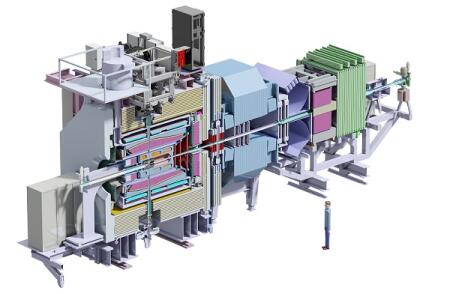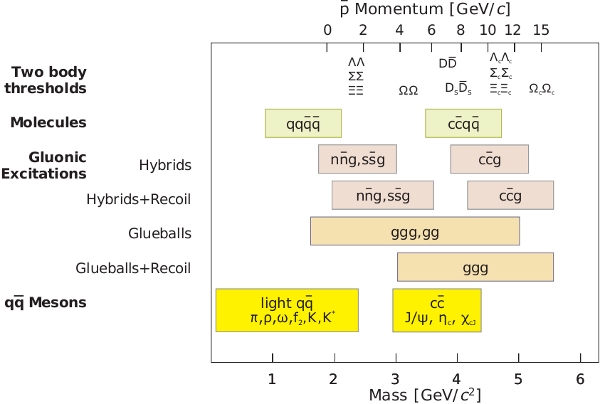The PANDA experiment
The PANDA experiment (AntiProton ANnihilations at DArmstadt) is one of the main experiments with a variety of intense research topics of the planned accelerator center FAIR (Facility for Antiproton and Ion Research) which will be build on the site of the GSI Helmholtzzentrum für Schwerionenforschung in Darmstadt. More information are available at the site of our funding partner BMBF site BMBF-Forschungsschwerpunkts ErUM-FSP T08: PANDA.
The PANDA experiment is a fixed target experiment which will be part of the high energy storage ring HESR. The antiprotons, which are accelerated and stored in the HESR, will collide with protons or deuterons inside the PANDA detector. The protons and deuterons have, compared to the antiprotons, such a small velocity, that they can be considered as particles at rest. In the HESR the antiprotons can be used in a momentum range between 1.5 and 15 GeV/c. Using different cooling methods (electron and stochastic cooling) the antiprotons will be provided with a small momentum spread of about 10-4 .
The PANDA detector will consist of a central and a forward detector which provide together an almost complete geometrical acceptance (4Pi detector). For this purpose, the different sub-detectors are arranged in an onion shell like fashion around the interaction point, which is typical for detectors for high energy physics. For the PANDA experiment two different target stations will be available: a cluster-jet target, which is developed and constructed in this working group, and a pellet target. Both target types have, according to the requirements, special properties which are essential for the complete experiment, so that, depending on the physics program, the most optimal target station can be installed.

The physics program of PANDA will focus on different aspects of the strong interaction. In the following figure, the hadrons are presented, which can be produced in the experiment by proton antiproton annihilations for this purpose:

The main aspects, which will be studied are:
- Charmonium spectroscopy:
The properties of mesons, consisting of pairs of charm and anti-charm quarks, will be investigated. Furthermore, there will be a thorough search for new, up to now unknown, excited states of these quark combinations. - Gluonic Excitations (glue balls and hybrids):
The theory of the strong interaction not only allows particles solely consisting of quarks, but also particles which include gluons, the exchange particles of the strong interaction, or are exclusively made out of gluons. There will be an extensive search for these particles, which are not observed until now. - Multi-quark states:
Except from the already known particles made out of two or three quarks, the theory also allows particles formed from four or five quarks. These particles have not been found yet and are therefore a very interesting objects of investigation. - Properties of hadrons in nuclear matter:
Based on the structure of the theory of the strong interaction (spontaneous breaking of the chiral symmetry), some of the properties of hadrons, i.e. their mass and life time, change in case they are produced or decay inside an atomic nucleus. The investigation of these effects will lead to a better understanding of the quantum chromodynamics and the validity of this theory.
